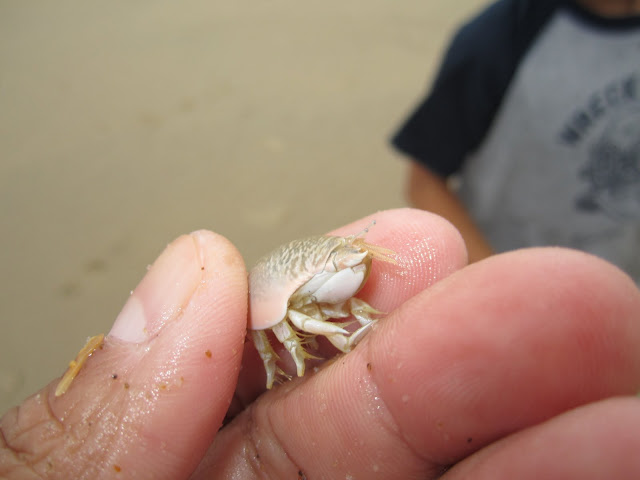Let's take a look at the 4 most common crabs to see at the beach.
Fiddler Crab
A personal favorite, these chipper little sand inhabitants seem to enjoy a good round of hide and seek, taunting nearby beach goers to a rousing game of "catch me if you can." These recluse creatures seem appear just long enough to dart across the open sand, hunting for scraps of food.
And just as the game seems a bit too easy, these little creatures disappear into the depths of their freshly carved sand tunnels.
As it's name suggests, this crab gets it's name from the motion of it's claws during feeding. The small claw gathers and eats food and appears to be "playing" the larger, fiddle-like claw.
The large claw might be one of the most interesting features of this little crustacean. Often fights break out between these crabs (most likely to impress potential female mates) and casualties can include the loss of a claw. Usually the smaller claw begins to grow in a large one and the lost claw regenerates, but this time returning as the smaller claw. Although, sometimes the lost large claw regenerates itself, but never reaches it's former size.
These busy creatures spend hours upon hours making fantastic displays of sand art. Their job is never done, it seems, as each day brings another long fight against approaching waves and home crushing sand.
Common Shore Crab
Of the most widespread species throughout the globe, this crab is found in shallow waters and estuaries, but can also live deep water. This aggressive scavenger crab is usually secondary consumer and feeds on any dead food it finds. It also eats worms, mollusks, algae and anything else it can catch such as other fish or creatures swimming by. These crabs are aggressive, often fighting with each other, and as a result, at least 5% of common shore crabs only have one claw.
A favorite pass time for many children involves dangling bait like shellfish or raw chicken on the end of a string to entice these hungry crawlers out of their well camouflaged homes under seaweed and rocks.
Horseshoe Crab
This ancient looking creature is commonly found washed up at the beach. It's prehistoric look is actually linked to the fact that the horseshoe crab is not a true crab or even a crustacean. Scientists categorized the horseshoe crab as an Arthropods, or a living fossil and classify them under the class Merostomata. Spiders and ticks are believed to be the closest present day relatives to the four known species of horseshoe crab.
Unknown to most, this ancient looking crab might just have saved your life...and mine. 'If you've ever received an indictable vaccine or indictable medical drug treatment you owe some thanks to this strange animal. The horseshoe crab's blue blood provides a way to test bacterial contamination in intravenous fluids. That means, the horseshoe crab may have saved your life, without you even knowing it. The unusual animals are collected, blood is taken, and the creatures are released back to the wild they came from.' (fact source)
Sand Crab
These mini-crabs don't have too much going for them. They can only walk backwards...yes, that's right. Backwards only. The sweet little legs of theirs don't have claws. Unlike most crabs which move in all directions, these darlings live life in one direction.
The shifting sand of the waters edge is home to these creatures and they spend life browsing the ever moving waves and sand for bits of plankton with their tiny feather like antennae. They sweep so quickly, in fact, that they can gather multiple feather-fulls of food with each passing wave.
By burrowing quickly and often, they can maintain balance in the rushing water. But if dislodged from the sand, they have the ability to tread water using their tiny back legs, an ability quite rare for a crustaceans.
These creatures might seem quite useless, but their filter feeding style is an important signal to dangerous toxins that often enter the ocean water through pollution and other contamination. Since sand crabs live at the waters edge, they are one of the first to ingest land-bound toxicity.
One naturally occurring toxin, Domoic acid, causes serious amnesic poisoning in higher animals, and occasionally in humans. This acid is a nerve toxin produced by microscopic, single celled plants that live in the ocean. As filtering feeders, sand crabs ingest the toxin and it progresses up the food chain. The amount of Domoic acid in the sand crabs flesh can indicate the amount of toxin in the water. (fact source found here)
Another interesting fact about these small creatures is their use in neurological studies conducted in laboratories. The tail of a sand crab has the largest sensory neurons found in any animal. For being the size of a bottle top, these little creatures pack a powerful punch.
In addition to their ultra sensitive tales, female sand crabs have the amazing ability to produce as many as 45,000 eggs and she can carry them on her abdomen for 30 days until the eggs hatch. The larvae live as drifting plankton for 2-4 months and water currents can carry them long distances from their origin. Sand crabs can reproduce during their first year of life and live for approximately







No comments:
Post a Comment